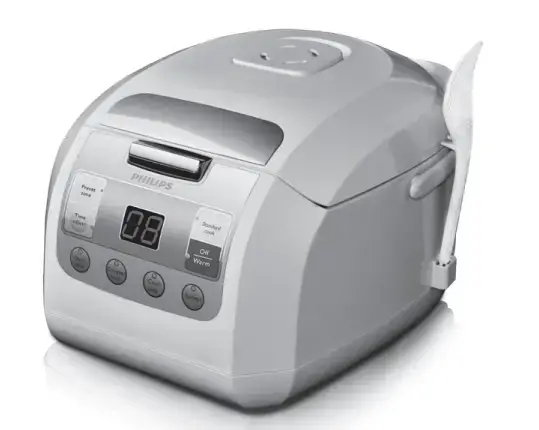

Congratulations on your purchase, and welcome to Philips!
To fully benefit from the support that Philips offers, register your product at www.Philips.com/welcome.
What’s in the box
- Fuzzy rice cooker main unit Rice scoop
- Measuring cup
- Safety leaflet
- Power cord Steam basket
- Soup ladle
- User manual
- Warranty card
Overview
| a | Fuzzy rice cooker main unit | j | Lid release button |
| b | Power cord | k | Control panel |
| c | Rice scoop | l | Main body |
| d | Soup ladle | m | Power plug |
| e | Steam basket | n | Heating element |
| f | Measuring cup | o | Water level indications |
| g | Top lid | p | Cooker handle |
| h | Sealing ring | q | Inner lid |
| i | Inner pot | r | Detachable steam vent cap |
Before first use
- Take out all the accessories from the inner pot. Remove the sheet between the inner pot and the heating element.
- Clean the parts of the rice cooker thoroughly before using the rice cooker for the first time (see chapter “Cleaning”).
Note Make sure all parts are completely dry before you start using the rice cooker.
Preparations before use
Before using the rice cooker, you need to follow the preparation:
- Measure the rice using the measuring cup provided.
- Wash the rice thoroughly.
- Put the pre-washed rice in the inner pot.
- Add water to the level indicated on the scale inside the inner pot that corresponds to the number of cups of rice used. Then smooth the rice surface.
- Press the release lever to open the lid.
- Put the inner pot in the rice cooker. Check if the inner pot is in proper contact with the heating element.
- Close the lid of the rice cooker, put the plug in the power socket.

Note
- Each cup of uncooked rice normally gives 2 bowls of cooked rice. Do not exceed the quantities indicated on the inside of the inner pot.
The level marked inside the inner pot is just an indication. You can always adjust the water level for different types of rice and your own preference. If the voltage is unstable at the area you live, it is possible that the rice cooker overflows. - Besides following the water level indications, you can also add rice and water at 1:1-1.2 ratio for rice cooking. Do not exceed the quantities indicated on the inside of the inner pot.
- Make sure that the outside of the inner pot is dry and clean, and that there is no foreign residue on the heating element or the magnetic switch.
Rice cooking
There are two rice cooking functions for HD3030.
- Cooking function and Estimated cooking time for 6 cups of rice
- Standard cook ( Standardcook
- 50 minutes
- Quick cook ( Quiccookk
- 38 minutes
Note
Follow the same steps for Quick cook
- Do not exceed the volume indicated nor exceed the maximum water level indicated in the inner pot, as this may cause the rice cooker to overflow.
- You can press the cancel button ( Off ) or unplug the rice cooker
- Warm to turn off the keep warm function or when not in use.
Cooking congee and making soup
- Cooking function and Estimated cooking time
- Cooking congee ( SoupCongee/
- 1 hour (for 1 cup of rice)
- Making soup ( SoupCongee/
- 1 hour
Note
- Do not exceed the volume indicated nor exceed the maximum water level indicated in the inner pot, as this may cause the rice cooker to overflow.
- You can press the cancel button ( Off ) or unplug the rice cooker Warm
- to turn off the keep warm function or when not in use.
- It is normal to find the congee more stickier if it is left in keep warm mode for too long.
Reheating
- Cooking function and Estimated cooking time
- Reheating ( Reheat )
- 25 minutes
- You can press the cancel button ( OffWarm ) or unplug the rice cooker to turn off the keep warm function or when not in use.
Preset time for delayed cooking
You can preset the delayed cooking time for rice, congee, and soup. The preset timer is available up to 24 hours.
- Do not exceed the volume indicated nor exceed the maximum water level indicated in the inner pot, as this may cause the rice cooker to overflow.
- Once the rice cooker enters preset mode, the preset time button ( Preset ) will not respond. time
- You can press the cancel button ( Off ) or unplug the rice cooker Warm to turn off the keep warm function or when not in use.
Cleaning and Maintenance
• Uplug the rice cooker before starting to clean it.
• Wait until the rice cooker has cooled down sufficiently before
Interior
- Inside of the outer lid and the main body:• Wipe with wrung out and damp cloth.
- Make sure to remove all the food residues stuck to the rice cooker. Heating element:
- Wipe with wrung out and damp cloth.
- Remove food residues with wrung out and damp cloth or toothpicks.
Exterior
- Surface of the outer lid and outside of the main body:• Wipe with a cloth damped with soap water.
- ONLY use soft and dry cloth to wipe the control panel.
- Make sure to remove all the food residues around the control buttons.
Accessories
Rice scoop, soup ladle, inner pot, steam basket, and steam vent cap:Soak in hot water and clean with sponge.
Recycling
Do not throw away the product with the normal household waste at the end of its life, but hand it in at an official collection point for recycling. By doing this, you help to preserve the environment. Follow your country’s rules for the separate collection of electrical and electronic products. Correct disposal helps prevent negative consequences for the environment and human health.
Guarantee and service
If you need service or information, or if you have a problem, visit the Philips website at www.philips.com or contact the Philips Customer Care Center in your country. You can find its phone number in the worldwide guarantee leaflet. If there is no Customer Care Center in your country, go to your local Philips dealer.
Troubleshooting
If you encounter problems when using this rice cooker, check the following points before requesting service. If you cannot solve the problem, contact the Philips Consumer Care Center in your country Following are the problems an d their solutions
- The lights on the buttons does not go on.
- There is a connection problem. Check if the power cord is connected to the cooker properly and if the plug is inserted firmly into the power outlet.
- The light is defective. Take the appliance to your Philips dealer or a service center authorized by Philips.
- The display does not function.
- The rice cooker is not connected to the power supply. If there is no power supply, the power failure backup function does not work and the display does not function.
- The battery for the display runs out of power. Take the appliance to your Philips dealer or a service center authorized by Philips to have the battery replaced.
- The rice is not cooked.
- There is not enough water. Add water according to the scale on the inside of the inner pot.You did not press the cooking function button.
- Make sure that there is no foreign residue on the heating element and the outside of the inner pot before switching the rice cooker on.
- The heating element is damaged, or the inner pot is deformed. Take the cooker to your Philips dealer or a service center authorized by Philips.
- The cooker does not switch to keep warm mode automatically
- The temperature control is defective. Take the appliance to your Philips dealer or a service center authorized by Philips.
- The rice is scorched.
- Make sure that you add water to the level indicated on the scale inside the inner pot that corresponds to the number of cups of rice used.
- Make sure the water does not exceed the next level on the scale, as this may cause the appliance to overflow during cooking.
- Rice smells bad Rice smells bad
- Clean the inner pot with some washing detergent and warm water.
- After cooking, make sure the steam vent cap, inner lid and inner pot is cleaned thoroughly.
- Error message (E1, E2, E3, or E4) appears on the display.
- There has been a power failure during cooking. Take the appliance to your Philips dealer or a service center authorized by Philips.

